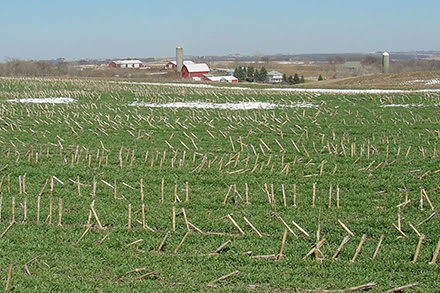www.no-tillfarmer.com/articles/12676-study-winter-rye-cover-crop-reduces-nitrate-losses-by-45

Winter rye cover crops offer multiple benefits, including carbon sequestration. (Photo by Tom Kasper, D3362-1)
Study: Winter Rye Cover Crop Reduces Nitrate Losses By 45%
August 11, 2023
Winter rye is prized for its versatility. It is a source of grain and also a forage and ground cover that protects the soil from erosion by wind and rain. But the benefits of winter rye don’t stop there.
A series of studies, begun in 2015, by a team of Agricultural Research Service (ARS) and university collaborators suggest that establishing a cover crop of winter rye between rotations of corn and soybean can reduce nitrate losses, sequester carbon and provide a source of renewable natural gas.
Robert Malone, an agricultural engineer with the ARS National Laboratory for Agriculture and the Environment in Ames, Iowa, is coordinating the studies to evaluate rye’s potential role in the "sustainable intensification of agriculture"—an approach deemed critical to meeting growing world demand for food, feed, fiber and fuel without overtaxing what the land and natural resources can provide.
In the latest studies, the team used a field-scale computer model to simulate rotations of corn and soybean, with or without winter rye cover crops, at 40 sites across the North Central United States, including parts of the Mississippi River Basin, which empties into the Gulf of Mexico.
Among results recently published in the journal of Environmental Research Letters:
10 Practices for Cutting Tile Nitrate Loads
- Establishing a winter rye cover crop between corn-soybean rotations in tile-drained fields (meaning, those using a system of underground drainage pipes to remove excess water) reduced nitrate levels in drainage water by more than 45 percent compared to rye-free fields—or about 21 and 44 kilograms per hectare, respectively.
- Across the 63-total million hectares (approximately 156 million acres) of North Central farmland that the model’s simulations encompassed, use of a winter rye cover crops on tile-drained fields translated to a 27 percent reduction in nitrate loads entering the Gulf of Mexico via the Mississippi River basin.
Related Content:
Replenishing Soil Carbon with Bioenergy Sorghum,
Winter Rye Provides Benefits as a Preceding Cover Crop for Dry Bean,
10 Practices for Cutting Tile Nitrate Loads
